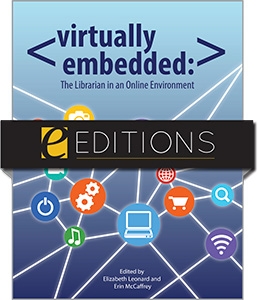
Virtually Embedded: The Librarian in an Online Environment--eEditions e-book
The download link for this product can be found on the final confirmation screen after you complete your purchase, and may also be accessed from your Account Profile. For more information about ALA eEditions file types and how to view them on eReaders, desktop computers, and other devices, see this page.
Primary tabs
You don't need to be an ALA Member to purchase from the ALA Store, but you'll be asked to create an online account/profile during the checkout to proceed. This Web Account is for both Members and non-Members.
If you are Tax-Exempt, please verify that your account is currently set up as exempt before placing your order, as our new fulfillment center will need current documentation. Learn how to verify here.
- Description
- Table of Contents
- About the authors
The rise of online education at institutions of higher learning, together with the increasing cost of higher education, lead some to suggest that online (or distance) education will eventually become the dominant form of higher learning. This has particular significance for librarians. This casebook, a blueprint for embedding academic librarians in online environments, from undergraduate to science-based graduate schools to MOOCs is the first to explore how librarians can play a key role in the virtual academic landscape. The authors, academic librarians representing a broad range of colleges and universities, look at the evolution of the embedded librarian from physical to virtual, suggest how to develop and implement unique programs in and out of the classroom, and explain how to scale programs once they are embedded.
This book is suitable for professional collections in academic libraries of all sizes and types. It is also suitable for collections in schools of library and information science.
Foreword: David Shumaker Introduction: Erin McCaffrey and Elizabeth Leonard
part one: the evolution of embedded librarianship
1. Online Embedded Librarians: A Review and Overview Linda Frederiksen and Sue F. Phelps
2. Embedded Librarians: Evolving and Expanding in Higher EducationAudrey Donaldson and Alyssa M. Valenti
part two: developing programs in the online embedded environment
3. Sustainable Embedded Librarianship to Foster Research Skills in an Online Graduate Program Swapna Kumar, Kristin Heathcock, and Marilyn N. Ochoa
4. Embedded Librarian in a Military Distance Education Program Catrina Whited, Bridget A. Powell, and Gail Nicula
5. From the Antipodes: Embedded Librarians at the Open Polytechnic of New Zealand Alison Fields and Philip Clarke
6. Web 2.0 Toolkit: A Guide for Virtually Embedded Librarians Chanitra Bishop and Christina Sheley
part three: online embedded librarians—outside the classroom
7. Avoiding Curricular Combat Fatigue: Embedding Librarians in E-Learning to Teach the Teacher Kathleen A. Langan
8. Not Just an Afterthought: Involving Librarians in the Instructional Design Process Alex Mudd, Terri Pedersen Summey, and Matt Upson
part four: embedded in the bigger picture—scaling online embedded librarianship
9. Win-Win: Embedding Future Librarians to Extend Service to Online Classes Timothy Peters and Julie LaDell-Thomas
10. Embedding in the LMS: Faculty Evaluations of a Low-Touch Widget Amy R. Hofer and Karen Munro
11. Linking to Course-Specific and Subject-Specific LibGuides from Blackboard Pru Morris and Deirdre R. McDonald
12. MOOCs: Getting Involved Elizabeth Leonard and Erin McCaffrey
About the Authors
Elizabeth Leonard
Elizabeth Leonard is the Assistant Dean of University Libraries for Information Technologies, Resources Acquisition and Description at Seton Hall University. She holds a MLIS from Rutgers University, a Masters in Urban Planning from NYU's Wagner School of Public Service, and doctoral work in Clinical Psychology. Additionally she has over 12 years of experience in Information Technology Management, specializing in project management, systems development and administration. Elizabeth is Chair of the Assessment, Evaluation, and Statistics Committee for the Virtual Academic Library Environment (VALE) ofNew Jersey, on the Board of the 2014 Distance Library Services Conference, and a co-founder, along with Naomi House, of the Facebook group, I Need a Library Job. She has published and presented on the subject of Online Libraries, marketing of online library services, and the value of academic libraries.
Erin McCaffrey
Erin McCaffrey is an electronic services librarian at Regis University in Denver, Colorado. Previously, she was a distance learning librarian at Regis University and an assistant instruction coordinator at DePaul University. Her research interests are in human-computer interaction and interactive media. She has experience in web-based library services, system administration, distance learning, and reference and instruction. Erin received her BA from DePaul University with a major in psychology and earned her MLIS degree from Dominican University.


